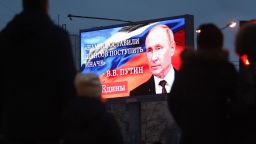Russia’s strategy in its war on Ukraine is shifting toward a “slow annihilation” of the Ukrainian military, US and other Western officials tell CNN, warning that Russia could focus on a bloody and deadly bombardment of cities and civilian targets as the conflict becomes a grinding war of attrition.
Ukrainian forces have so far been able to stave off Russia’s initial push, maintaining control of Kyiv and other major cities. But they remain massively outgunned and outmanned. And Russia is now bringing in heavier, more destructive weaponry and increasingly striking civilian infrastructure, after an initial focus on military targets, the officials said.
The shift in strategy likely reflects a recognition by Russian President Vladimir Putin that his initial plan to quickly topple Kyiv has failed, said one senior Western intelligence official – in part because the Ukrainians have put up a stiffer than anticipated fight and in part because logistics and supply missteps have slowed the Russian advance.
But Western officials now expect that Russia will ramp up heavy weapons bombardment of Ukraine’s cities and potentially march in “tens of thousands” of troops, one US official said. Eventually, officials caution, Ukraine’s military will likely run short of supplies needed to keep up the fight.
The US has delivered hundreds of Stinger missiles to Ukraine over the last few days, including more than 200 on Monday, according to a US official and a congressional source briefed on the matter. But the US and NATO have made it clear they will not commit troops to defending Ukraine.
‘Cruel military math’
Ukraine’s will to fight “is extending this,” said the senior Western intelligence official. “But the cruel military math of this will eventually come to bear, absent some intervention, absent some fundamental change in the dynamic.”
For Ukraine, whose military forces and civilian population have shown no signs of capitulating, the war appears poised to become a grim struggle for survival over a protracted, uncertain future.
The numbers are already bleak: Russia has lost roughly 3% to 5% of its tanks, aircraft, artillery and other military assets inside Ukraine — compared with Ukrainian losses of roughly 10% of its capabilities, according to two US officials familiar with the latest intelligence.
Moscow has leaned heavily on its more modern precision cruise missiles, according to a source familiar with the intelligence, heavily degrading Ukraine’s military infrastructure. Meanwhile, Ukraine has continued to burn through its supply of shoulder-fired Javelin missiles.
Western security assistance has flowed across the border into Ukraine in recent days, defense and intelligence officials say, although they have declined to provide details on how much, precisely what kind or how it is getting to the embattled Ukrainian forces.
Public statements from Ukrainian officials suggest it’s not enough.
Ukrainian Foreign Minister Dmytro Kuleba told Secretary of State Antony Blinken in a call Wednesday that Ukraine needs additional deliveries of weapons “now,” Kuleba tweeted.
“They need bullets. They need bandages. They’re going to need fuel. They’re going to need ammunition, in addition to the humanitarian support to help with medical assistance, sustaining hospitals, both for combat wounded and for civilians that are being hurt,” the senior intelligence official said of Ukrainian supplies.
“And they’re going to need a lot again in ammunition and the weapons resupply, because the Russian force is both numerically and qualitatively superior,” this person said.
Fears of civilian casualties
In addition to grinding down Ukraine’s military, US and other Western officials fear Russia’s siege tactics will cause heavy civilian casualties as Moscow aims to ultimately take Ukraine’s capital of Kyiv.
While the first few nights of Russia’s campaign were aimed at military sites, during the last three there have been missile, artillery and rocket attacks against many civilian areas, where there may be administrative buildings but no security installations.
CNN has been able to confirm attacks in Irpin, near Kyiv, as well as Mariupol, Borodjanka, Kharkiv and Kherson.
US Ambassador to the United Nations Linda Thomas-Greenfield accused Russia of bringing weapons banned under the Geneva Conventions into Ukraine on Wednesday.
“We have seen videos of Russian forces moving exceptionally lethal weaponry into Ukraine, which has no place on the battlefield. That includes cluster munitions and vacuum bombs – which are banned under the Geneva Convention,” she said.
A senior defense official said Tuesday that the US could not prove that cluster munitions or vacuum bombs had been used by the Russian military.
“We’re likely to see an expansion of what we’ve seen in the last 48 hours, which is already a great degree of civilian infrastructure damage – whether intentional or unintentional,” said the senior intelligence official. “The violence level will go up. The numbers of refugees will go up. The numbers of civilian casualties and civilian dead will go up.”
Russians turning to heavier forces
To be sure, the Russian military’s offensive has faced numerous problems – some of its own making, officials say.
A 40-mile-long convoy of tanks, armored vehicles and towed artillery positioned north of Kyiv is “stalled,” the senior defense official said Wednesday.
The official said the US assesses there are multiple factors that appear to have slowed Russia’s move on Kyiv, including fuel and food problems, an effective, “stiff resistance” from Ukrainians and potential morale problems within Russia’s ranks.
But the official cautioned that the Russians would learn from their mistakes and adapt.
The Western intelligence official said that a week into the war, the Russian military appears to have realized its initial approach to Ukraine was problematic, which relied on the use of lighter units that were more mobile but less able to support themselves.
“I think part of what you’re seeing is them now catching up, seeing now it’s time to introduce heavier troops,” the official said. “I think the concern we have is that they seem to be now bringing in heavier forces, with more armor, more long-range artillery, heavier weapons, that are not just more destructive in their nature but, frankly, are also less precise.”
Social media posts and open-source intelligence, as well as videos and other information released by Ukraine, have suggested that many Russian troops were unprepared for or even uninformed of the true nature of the mission they were being sent to accomplish. Based on that open-source reporting, Western officials believe that troop morale, at least among some ground units, is very low, officials told CNN.
That could also slow Russian progress, officials said. Perhaps equally significant are Ukrainian efforts to publicize Russian casualties and allow captured Russian soldiers to call their loved ones at home – efforts that could inform the Russian population of the war being waged in their name abroad.
“They [Russia] have to prevent knowledge of Russian combat losses in their own domestic audience in a way they have in every other conflict that they had not supposedly participated in,” the Western intelligence official said. “And they’ll go to great lengths domestically to prevent that word from getting out.”
Estimates of Russian casualties vary; Ukraine on Wednesday said 6,000 Russians have been killed or wounded, while US sources familiar with the intelligence say the assessment is closer to 2,000 or 3,000.
CNN’s Natasha Bertrand, Kylie Atwood and Zachary Cohen contributed to this report.










